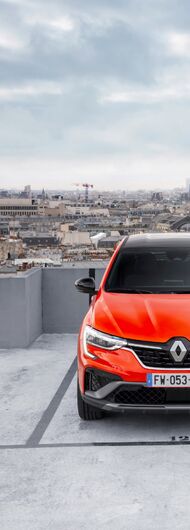
| |
| Renault 6 | |
|---|---|
| Renault | |
| aka | None |
| Production | 1968-1986 |
| Class | Small family car |
| Body Style | 5-door hatchback |
| Length | 3,860 mm (152.0 in) |
| Width | 1,540 mm (60.6 in) |
| Height | 1,500 mm (59.1 in) |
| Wheelbase | 2,400 mm (94.5 in) (left)
2,400 mm (94.5 in) (right) |
| Weight | 750 kg (1,653 lb) (1970) |
| Transmission | transmission + drive |
| Engine | 845 cc 800-02/B1B I4
956 cc C1C I4 (Spain) 1108 cc C1E I4 |
| Power | N/A hp @ N/A rpm N/A lb-ft of torque @ N/A rpm |
| Similar | Renault 4 |
| Designer | Designer (lead designer if it was a team effort) |
The Renault 6 is a small family car produced by the French automaker Renault between 1968 and 1986.
The Renault 6 was launched at the 1968 Paris Motor Show, and was intended to be an upmarket alternative to the Renault 4 that would compete with the Citroën Ami 6 and the recently launched Citroën Dyane. It used a similar dashboard-mounted gear-lever and over-the-engine linkage to that used in the Renault 4 and the small Citroëns with which it competed. The R6 used the R4 platform as well as its 845 cc engine and was technically near-identical, but its hatchback body was larger and more modern. Visually it resembled the Renault 16.
See Autopedia's comprehensive Renault 6 Review.
Development[]
In its first two years of production, the R6 was criticised by the press for the R4-derived engine's lack of power in the heavier R6. In part because of this, the R6 had worse fuel economy than the larger and outdated Renault 8, which had a bigger engine and better performance as well.
1970[]
However, an additional version of the R6 using the 1.1 litre Cléon-Fonte engine(an engine used in the Renault 8 since 1962) was unveiled at the 1970 Paris Motor Show and was widely regarded as a big improvement. Power was increased from 34 to 45 PS (25 to 33 kW). The smaller engined model continued to be available until June 1979; it was sold as the Renault 6 L after August 1977.
The new car also had higher equipment levels as well a new gearbox, cooling system and front disc brakes. The new cooling system necessitated a supplementary grille beneath the original one (in the place occupied by the license plate of the R6-850), while the disc brakes meant slightly redesigned rims with openings in them. For the Spanish market the R6 was made available with a 956 cc engine, due to vehicles over 1040 cc being taxable under Spanish regulations. Later, a 1037 cc engine was fitted, and from 1981 the 1108 cc unit appeared in the 6 GTL. The one-litre version has 50 PS (37 kW) DIN and this engine was also fitted to Spanish-built 5s and 7s. The R6 continued to be built in Spain until 1986, with a total of 328,000 cars built there.
In 1973 the Teilhol/ACL-built 6 Rodéo appeared. This was an open, plastic-bodied utility vehicle in the style of the Citroën Méhari, which was sold by selected Renault dealers. A four-wheel-drive system by Sinpar was also available to the Rodéo as well as the 6 saloon.
Facelift[]
In June 1973 the R6 was revamped with square headlights, new rear lights, a plastic grille, and new bumpers. The front indicator lights also moved from between the bumper and the headlights to the bumper itself. The mechanicals remained untouched. In 1978 there was a very mild facelift, with a black grille being the most obvious change.
International production[]
Production and sales in France and most of Europe ended in 1980 with no direct successor, but in Spain and Argentina the car was still produced and sold until 1986. Renault had launched a similar-sized hatchback, the Renault 14, in 1976 - aiming it directly at Volkswagen's highly successful new Golf, which popularised the hatchback bodystyle on cars of this size more than any other model.
In Argentina, where the car was built by IKA-Renault, the original design (without the additional grille seen on European 1100s) continued until it received a facelift in 1978 along with a name change to "6 GTL". This meant a one-piece black grille, including the headlight surrounds, as well as black bumpers. Meanwhile, a 1397 cc engine (M1400) with 60 PS (44 kW) SAE was fitted to the Argentinian-made cars. From 1969 until 1978 it was fitted with an 1118 cc version of the Cléon engine (M1100) with 51 PS (38 kW). In total, 80,869 R6s were built in Argentina, with the pre-facelift model accounting for 57,534 (71 percent) of the total.
In Colombia the car was discontinued in 1984, when the Renault 9 started production.
See Also[]

|
This page uses some content from Wikipedia. The original article was at Renault 6. The list of authors can be seen in the page history. As with Autopedia, the text of Wikipedia is available under the GNU Free Documentation License. |
External Links[]
Please include any external sites that were used in collaborating this data, including manufacturer sites, in this section.
News and References
Enthusiast Sites and Discussion Forums
